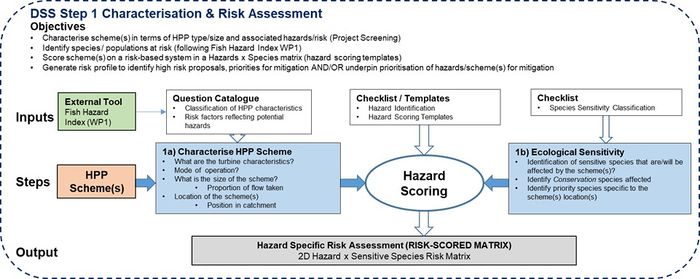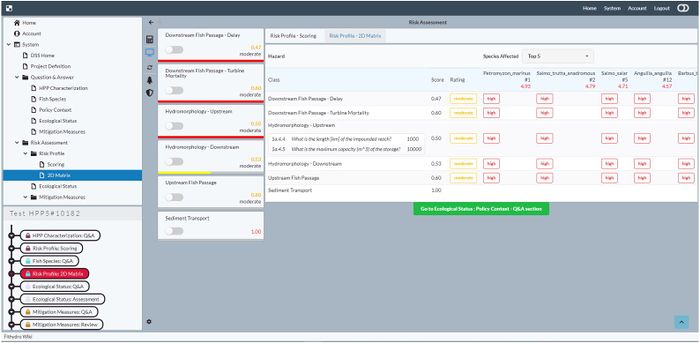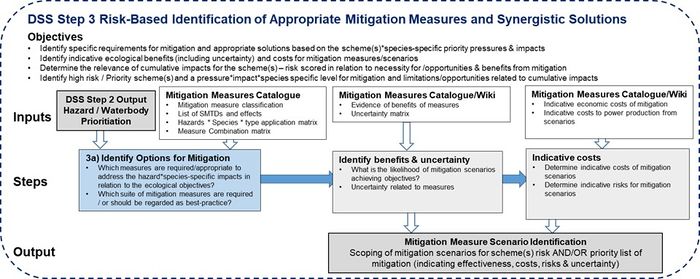Difference between revisions of "Decision Support System Steps"
Bendikhansen (talk | contribs) |
Bendikhansen (talk | contribs) |
||
| (22 intermediate revisions by the same user not shown) | |||
| Line 4: | Line 4: | ||
===Decision Framework=== | ===Decision Framework=== | ||
The objective of the first step of the planning and decision framework is to characterize the HPP (existing or proposed) in terms of its design (general layout, scale, turbine type, mode of operation), then identify and score the inherent risks posed by the type and size of scheme in relation to its context. There are three tasks in this process, the first task characterizes the HPP in terms of its location, design and operation, the second task is to identify the species/populations at risk and the third task is to identify and risk assess the key hazards associated with the scheme. | The objective of the first step of the planning and decision framework is to characterize the HPP (existing or proposed) in terms of its design (general layout, scale, turbine type, mode of operation), then identify and score the inherent risks posed by the type and size of scheme in relation to its context. There are three tasks in this process, the first task characterizes the HPP in terms of its location, design and operation, the second task is to identify the species/populations at risk and the third task is to identify and risk assess the key hazards associated with the scheme. | ||
| − | [[file:DSS_step_1.jpeg| | + | |
| + | [[file:DSS_step_1.jpeg|thumb|none|700px|caption|Conceptual flow diagram of Step 1 of the proposed Decision Support System Framework - Pre-screening characterization and risk identification. Grey = outputs/inputs to/from steps; blue = tasks; White = FIThydro inputs and matrices; Green = final output/objective.]] | ||
| + | |||
===Web-tool implementation=== | ===Web-tool implementation=== | ||
Step 1 in the tool comprises a questionnaire and hazard-scoring template to identify the key hazards posed by a specific HPP and the species of fish likely to be affected. The FIThydro DSS tool identifies the risk posed by a hazard as the combination of the hazard score (the nature and effect of the hazard) in combination with the sensitivity of the species that are affected. As such the risk scoring of a hazard is completed within a 2D matrix to determine the risk profile and assign summary risk classes to each relevant hazard. The risk score for each hazard and species combination is determined using a cross-tab lookup table from the Hazard risk class (named the hazard rating) and species sensitivity class (sensitivity to additional mortality caused by hydropower). | Step 1 in the tool comprises a questionnaire and hazard-scoring template to identify the key hazards posed by a specific HPP and the species of fish likely to be affected. The FIThydro DSS tool identifies the risk posed by a hazard as the combination of the hazard score (the nature and effect of the hazard) in combination with the sensitivity of the species that are affected. As such the risk scoring of a hazard is completed within a 2D matrix to determine the risk profile and assign summary risk classes to each relevant hazard. The risk score for each hazard and species combination is determined using a cross-tab lookup table from the Hazard risk class (named the hazard rating) and species sensitivity class (sensitivity to additional mortality caused by hydropower). | ||
| + | |||
| + | [[file:DSS_step_1_SS.jpeg|thumb|700px|none|caption|FIThydro DSS Risk Profile – Hazard Scoring screen, indicating the identified hazard classes applicable to the HPP and the scoring template used for one of the hazard classes.]] | ||
| + | |||
| + | =Step 2 - Ecological status assessment and review of existing mitigation= | ||
| + | ===Decision Framework=== | ||
| + | The second step in the framework builds on the risk assessment pre-screening and determines the priorities for the scheme in relation to the ecological status and environmental/conservation objectives. This step provides a risk assessment for the ecological status of the waterbodies affected by the scheme/hazards and also reviews the presence and effectiveness of existing mitigation measures. The output of this step firstly is a prioritised list of hazards for the scheme(s) (with the scheme(s) scores based on the actual status of, and objectives for, the waterbodies affected). The second output is an evaluation of existing mitigation measures (against permitting/legislative requirements and understanding of specific effectiveness) to identify priority hazards for further mitigation and the specific measures that may need improving. | ||
| + | |||
| + | [[file:DSS_step_2.jpeg|thumb|700px|none|caption|Conceptual flow diagram of Step 2 of the proposed Decision Support System Framework – Ecological Pressures and Impacts Characterisation and Risk Identification. Grey = outputs/inputs to/from steps; blue = tasks; White = FIThydro inputs and matrices; Green = final output/objective.]] | ||
| + | |||
| + | ===Web-tool implementation=== | ||
| + | In Step 2 a targeted questionnaire and scoring system is used to determine the status of the host waterbody for the scheme(s) according to the environmental policies that govern the scheme(s) and the evidence for known impacts on fish and waterbodies from national level assessments. The decision maker has to select status assessment categories from a pre-defined checklist for international directives and input data for national and regional regulations/legislations and associated assessments. The aim of this section is to determine the risk associated with a scheme in terms of causing a net deterioration in ecological/conservation status, and framing the scheme in terms of the objectives and legal requirements for mitigation. A number of metrics are presented to the user in a hazard matrix and a summary metric is calculated as the sum of the protected site score and the ecological status scores. This summary score is used as a prioritisation metric to rank the hazards in the hazard summary screen and also used to order the hazards in order of requiring mitigation. | ||
| + | |||
| + | [[file:DSS_step_2_SS.jpeg|thumb|700px|none|caption|FIThydro DSS ecological status risk matrix identifying the calculated Protect Site Score, Ecological Status Risk Score and indicating whether priority quality elements (fish, hydromorphology, continuity) are identified as a reason for failing the objectives and whether the HPP has been identified in river basin management plans to be significantly contributing to a failure to achieve good ecological status. These components are combined into the Hazard/waterbody priority score metric.]] | ||
| + | |||
| + | =DSS Step 3 - Risk-Based Identification of Appropriate Mitigation Measures and Synergistic Solutions= | ||
| + | ===Decision Framework=== | ||
| + | The third step of the decision framework requires the identification of the most appropriate mitigation measures and potential synergistic solutions for the high-risk hazards and impacts that have been identified in the preceding steps (Figure 2-5). The “hazard-species” risk matrix that results from Step 2 of the framework is cross-referenced to the review of existing mitigation measures from which point the decision maker needs to identify what alternative options would be appropriate and potentially most cost-effective. The aim of this step is also to be able to scope different measures based on an assessment of the benefits of the mitigation measures and the likelihood of their success in achieving environmental objectives (risk and uncertainty). This step also identifies the indicative costs of the mitigation scenarios selected both in economic terms and in terms of any loss of power production. | ||
| + | |||
| + | [[file:DSS_step_3.jpeg|thumb|700px|none|caption|Conceptual flow diagram of Step 3 of the proposed Decision Support System Framework – Risk-Based identification of Appropriate Mitigation Measures and Synergistic Solutions. Grey = outputs/inputs to/from steps; blue = tasks; White = FIThydro inputs and matrices; Green = final output/objective.]] | ||
| + | |||
| + | ===Web-tool implementation=== | ||
| + | The final step in the screening tool is to scope the potential measures that could be effectively applied to mitigate the impacts of each specific hazard. In this task the user is asked to identify options for: | ||
| + | * New measures | ||
| + | * Existing measures that need to be improved (e.g. modified designs based on improved knowledge and technological developments) | ||
| + | * Measures that will need further investigation within the detailed project plan. | ||
| + | During the selection process, the user is provided with the FIThydro mitigation measures catalogue and asked to identify which measures they would like to select or modify. The user is asked to do this per hazard class and is directed to approach this in sequence from the highest priority hazard (the highest prioritisation score in relation to ecological status) to the lowest (hazard classes are ordered in sequence in the hazard class summary panel). To further inform the prioritisation the hazard class summary panel also contains the summary metrics for hazard score (numeric), the summary risk class (low, moderate, high) and indicates whether the user has previously indicated in the review of existing mitigation measures that the hazard definitely requires further improvement on mitigation. To enable the user to make informed decisions and selections the DSS provides the user with an overview of knowledge from the measures catalogue and links directly to the FIThydro wiki. | ||
| + | |||
| + | [[file:DSS_step_3_SS.jpeg|thumb|700px|none|caption|FIThydro DSS new measures selection interface where the user is asked to select new measures per hazard class and to identify (where applicable) which existing measures require replacement (i.e. be removed), improvement with new designs and/or need further investigations in a detailed project plan. The interface provides the user with summary metrics on effectiveness and limitations from the measures catalogue and gives links to the wiki for further information.]] | ||
| + | |||
| + | =Step 4 - Risk-Based Decision of Scheme Plan OR Prioritised Cost-Efficient Mitigation Plan= | ||
| + | ===Decision Framework=== | ||
| + | The final step of the framework is for the decision maker to be able to make a justified decision about the proposal of a new HPP, to be able to select the most appropriate mitigation scenario for an existing scheme (which will need further detailed site-specific assessment) or to be able to prioritise mitigation scenarios and plans for a portfolio of schemes (Figure 2-6). This step requires the user to determine whether the mitigation measures selected are likely to 1) meet legislative/policy requirements; and 2) be effective in protecting fish populations. This requires the mitigation measure scenario lists produced in the preceding step to be reviewed and assessed against the ecological objectives and national policy requirements for mitigation identified in Step 1 and the likely costs of the scenario. There are three steps that are typically considered at the final stage of the decision making process for hydropower permitting. | ||
| + | * Further detailed assessments (e.g. full EIA) | ||
| + | * Integrated Catchment Planning / Cumulative Impact Assessment | ||
| + | * Consultation with Stakeholders | ||
| + | |||
| + | [[file:DSS_step_4.jpeg|thumb|700px|none|caption|Conceptual flow diagram of Step 4 of the proposed Decision Support System Framework – Risk-Based Decision of Scheme Plan OR Prioritised Cost-Efficient Mitigation Plan. Grey = outputs/inputs to/from steps; blue = tasks; White = FIThydro inputs and matrices; Green = final output/objective.]] | ||
| + | |||
| + | ===Web-tool implementation=== | ||
| + | The DSS tool does not implement Step 4 of the planning framework (e.g. detailed mitigation plan, strategic planning, cost: benefit analysis, stakeholder consultation etc.), the tool is, however, focused on providing the capacity for scoping of these steps and identification of the evidence to underpin them. | ||
Latest revision as of 11:53, 27 October 2020
See Decision support system for general information about the DSS.
Contents
- 1 Step 1 - HPP Characterization & Risk Identification
- 2 Step 2 - Ecological status assessment and review of existing mitigation
- 3 DSS Step 3 - Risk-Based Identification of Appropriate Mitigation Measures and Synergistic Solutions
- 4 Step 4 - Risk-Based Decision of Scheme Plan OR Prioritised Cost-Efficient Mitigation Plan
Step 1 - HPP Characterization & Risk Identification
Decision Framework
The objective of the first step of the planning and decision framework is to characterize the HPP (existing or proposed) in terms of its design (general layout, scale, turbine type, mode of operation), then identify and score the inherent risks posed by the type and size of scheme in relation to its context. There are three tasks in this process, the first task characterizes the HPP in terms of its location, design and operation, the second task is to identify the species/populations at risk and the third task is to identify and risk assess the key hazards associated with the scheme.
Web-tool implementation
Step 1 in the tool comprises a questionnaire and hazard-scoring template to identify the key hazards posed by a specific HPP and the species of fish likely to be affected. The FIThydro DSS tool identifies the risk posed by a hazard as the combination of the hazard score (the nature and effect of the hazard) in combination with the sensitivity of the species that are affected. As such the risk scoring of a hazard is completed within a 2D matrix to determine the risk profile and assign summary risk classes to each relevant hazard. The risk score for each hazard and species combination is determined using a cross-tab lookup table from the Hazard risk class (named the hazard rating) and species sensitivity class (sensitivity to additional mortality caused by hydropower).
Step 2 - Ecological status assessment and review of existing mitigation
Decision Framework
The second step in the framework builds on the risk assessment pre-screening and determines the priorities for the scheme in relation to the ecological status and environmental/conservation objectives. This step provides a risk assessment for the ecological status of the waterbodies affected by the scheme/hazards and also reviews the presence and effectiveness of existing mitigation measures. The output of this step firstly is a prioritised list of hazards for the scheme(s) (with the scheme(s) scores based on the actual status of, and objectives for, the waterbodies affected). The second output is an evaluation of existing mitigation measures (against permitting/legislative requirements and understanding of specific effectiveness) to identify priority hazards for further mitigation and the specific measures that may need improving.
Web-tool implementation
In Step 2 a targeted questionnaire and scoring system is used to determine the status of the host waterbody for the scheme(s) according to the environmental policies that govern the scheme(s) and the evidence for known impacts on fish and waterbodies from national level assessments. The decision maker has to select status assessment categories from a pre-defined checklist for international directives and input data for national and regional regulations/legislations and associated assessments. The aim of this section is to determine the risk associated with a scheme in terms of causing a net deterioration in ecological/conservation status, and framing the scheme in terms of the objectives and legal requirements for mitigation. A number of metrics are presented to the user in a hazard matrix and a summary metric is calculated as the sum of the protected site score and the ecological status scores. This summary score is used as a prioritisation metric to rank the hazards in the hazard summary screen and also used to order the hazards in order of requiring mitigation.
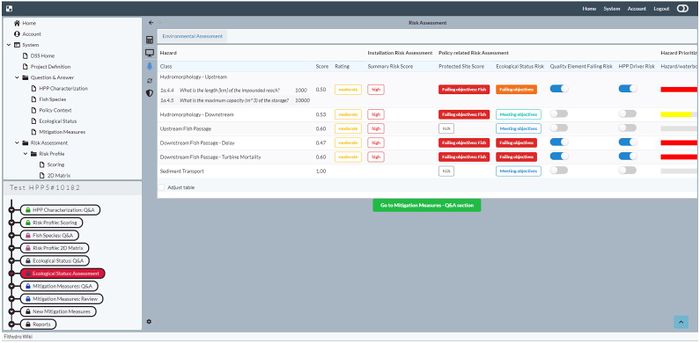
DSS Step 3 - Risk-Based Identification of Appropriate Mitigation Measures and Synergistic Solutions
Decision Framework
The third step of the decision framework requires the identification of the most appropriate mitigation measures and potential synergistic solutions for the high-risk hazards and impacts that have been identified in the preceding steps (Figure 2-5). The “hazard-species” risk matrix that results from Step 2 of the framework is cross-referenced to the review of existing mitigation measures from which point the decision maker needs to identify what alternative options would be appropriate and potentially most cost-effective. The aim of this step is also to be able to scope different measures based on an assessment of the benefits of the mitigation measures and the likelihood of their success in achieving environmental objectives (risk and uncertainty). This step also identifies the indicative costs of the mitigation scenarios selected both in economic terms and in terms of any loss of power production.
Web-tool implementation
The final step in the screening tool is to scope the potential measures that could be effectively applied to mitigate the impacts of each specific hazard. In this task the user is asked to identify options for:
- New measures
- Existing measures that need to be improved (e.g. modified designs based on improved knowledge and technological developments)
- Measures that will need further investigation within the detailed project plan.
During the selection process, the user is provided with the FIThydro mitigation measures catalogue and asked to identify which measures they would like to select or modify. The user is asked to do this per hazard class and is directed to approach this in sequence from the highest priority hazard (the highest prioritisation score in relation to ecological status) to the lowest (hazard classes are ordered in sequence in the hazard class summary panel). To further inform the prioritisation the hazard class summary panel also contains the summary metrics for hazard score (numeric), the summary risk class (low, moderate, high) and indicates whether the user has previously indicated in the review of existing mitigation measures that the hazard definitely requires further improvement on mitigation. To enable the user to make informed decisions and selections the DSS provides the user with an overview of knowledge from the measures catalogue and links directly to the FIThydro wiki.
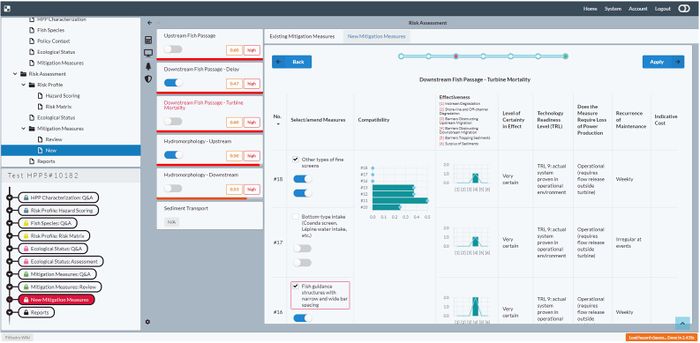
Step 4 - Risk-Based Decision of Scheme Plan OR Prioritised Cost-Efficient Mitigation Plan
Decision Framework
The final step of the framework is for the decision maker to be able to make a justified decision about the proposal of a new HPP, to be able to select the most appropriate mitigation scenario for an existing scheme (which will need further detailed site-specific assessment) or to be able to prioritise mitigation scenarios and plans for a portfolio of schemes (Figure 2-6). This step requires the user to determine whether the mitigation measures selected are likely to 1) meet legislative/policy requirements; and 2) be effective in protecting fish populations. This requires the mitigation measure scenario lists produced in the preceding step to be reviewed and assessed against the ecological objectives and national policy requirements for mitigation identified in Step 1 and the likely costs of the scenario. There are three steps that are typically considered at the final stage of the decision making process for hydropower permitting.
- Further detailed assessments (e.g. full EIA)
- Integrated Catchment Planning / Cumulative Impact Assessment
- Consultation with Stakeholders
Web-tool implementation
The DSS tool does not implement Step 4 of the planning framework (e.g. detailed mitigation plan, strategic planning, cost: benefit analysis, stakeholder consultation etc.), the tool is, however, focused on providing the capacity for scoping of these steps and identification of the evidence to underpin them.
